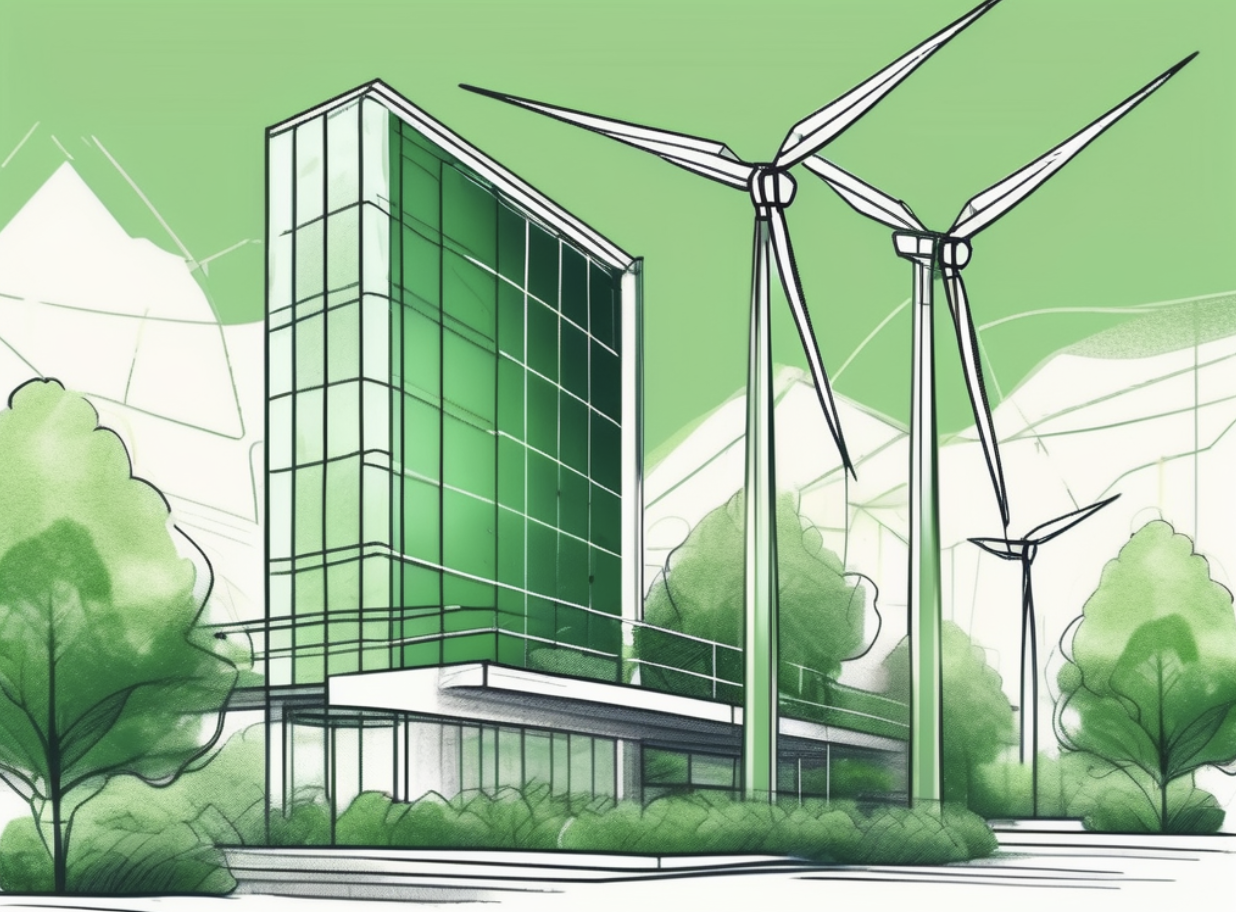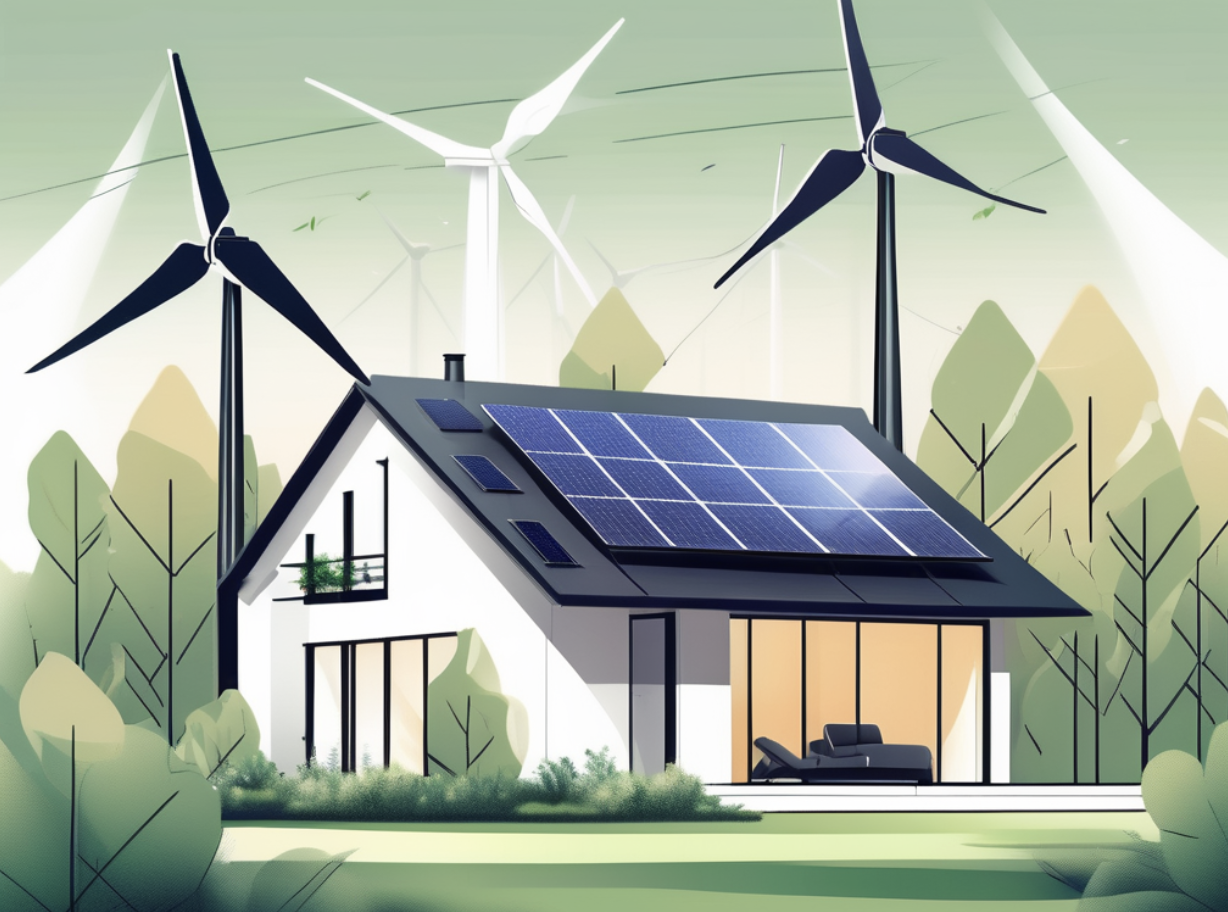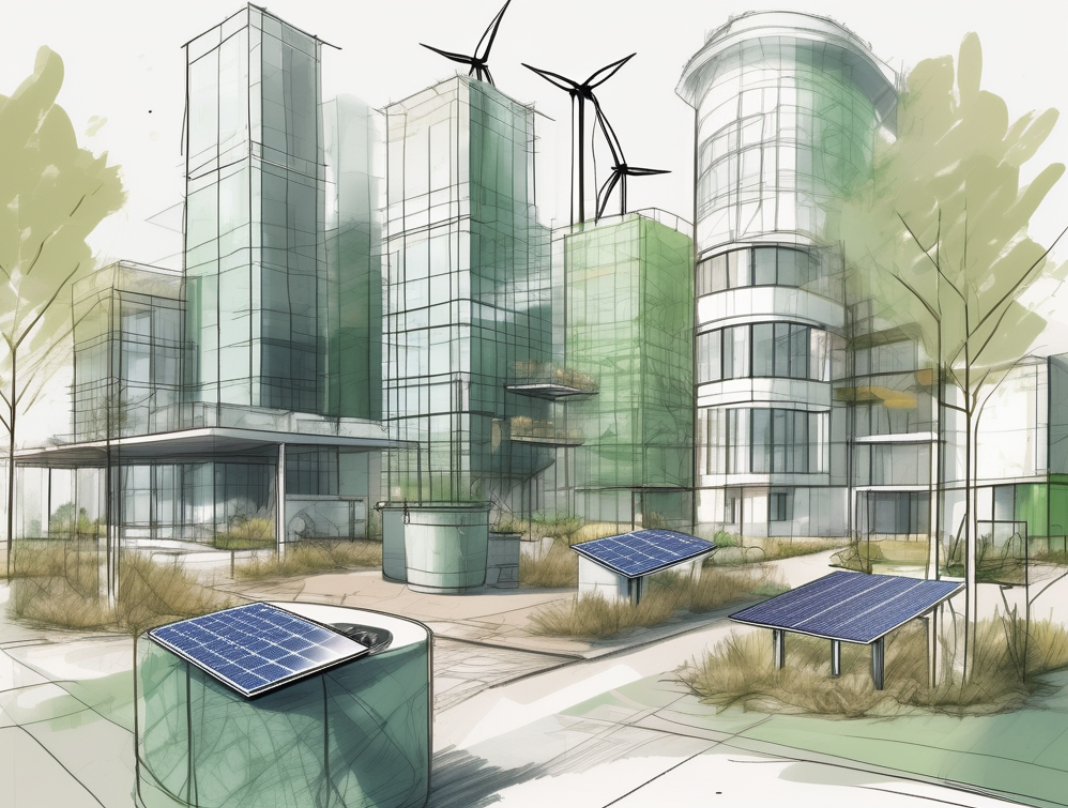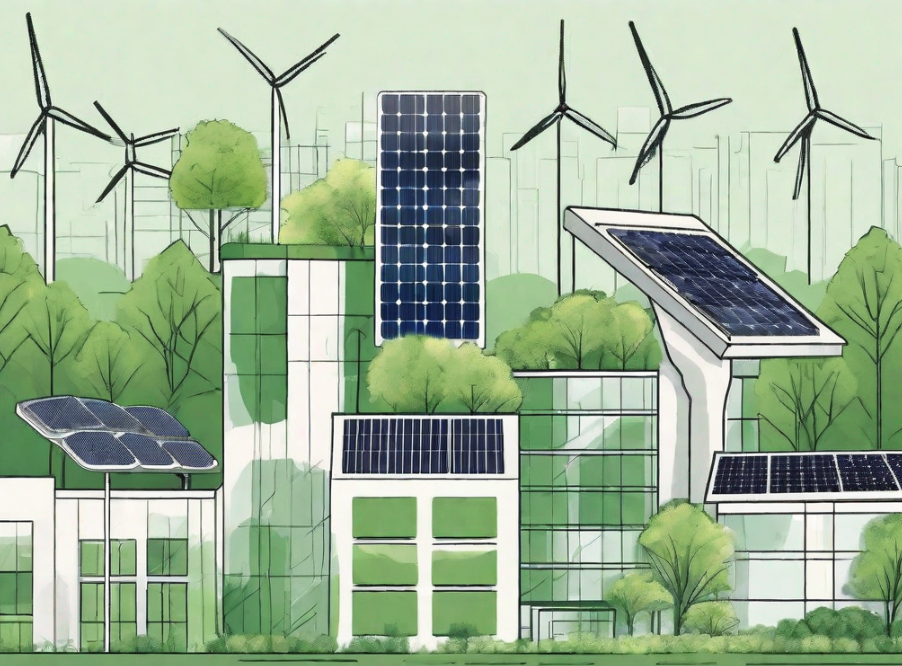What Are Some Environmental Advantages of Building Green?
What Are Some Environmental Advantages of Building Green?
Discover how building green can benefit the environment in a myriad of ways.

Green building is a concept that has gained significant attention in recent years, as individuals and organizations alike recognize the importance of sustainable development and environmental conservation. This article aims to explore the various environmental advantages of building green, highlighting key principles, benefits, and the role of green building in waste reduction, enhancing biodiversity and ecosystems, improving indoor environmental quality, and the future of this sustainable approach.
Understanding the Concept of Green Building
Before delving into the environmental advantages of green building, it is essential to have a clear understanding of what exactly this concept entails. Green building refers to the construction and renovation of buildings using environmentally-friendly methods and materials. It seeks to minimize the impact on natural resources, reduce waste generation, and promote energy efficiency. By adopting sustainable practices from the initial design stage to the final construction and operation, green buildings aim to mitigate their environmental footprint and create healthier spaces for occupants.
Defining Green Building
Green building encompasses a comprehensive range of practices and strategies that prioritize sustainability. These may include utilizing renewable energy sources, implementing efficient water management systems, employing eco-friendly construction materials, and incorporating innovative design techniques to optimize energy performance and indoor environmental quality.
Key Principles of Green Building
There are several fundamental principles that underpin green building. First and foremost, it focuses on energy efficiency, striving to minimize energy consumption through insulation, efficient lighting systems, and the use of renewable energy sources such as solar panels or geothermal heating. Secondly, it promotes water conservation by utilizing rainwater harvesting systems, low-flow fixtures, and wastewater treatment technologies. Thirdly, green buildings prioritize the use of sustainable materials that have lower environmental impacts, such as recycled or locally sourced materials. Lastly, effective waste management through recycling and minimizing construction waste is another key principle of green building.
Furthermore, green building practices extend beyond the construction phase. Once a green building is operational, it continues to contribute to sustainability through ongoing maintenance and operations. This includes regular monitoring of energy and water usage, optimizing building systems for maximum efficiency, and implementing occupant education programs to promote sustainable behaviors.
Moreover, green buildings have a significant impact on the health and well-being of occupants. By prioritizing indoor environmental quality, green buildings aim to provide a comfortable and healthy living or working environment. This involves factors such as proper ventilation, natural daylighting, and the use of low-emission materials to reduce indoor air pollution. Studies have shown that occupants of green buildings experience improved productivity, reduced absenteeism, and enhanced overall well-being.
Environmental Benefits of Green Building
One of the most significant advantages of green building is the positive impact it has on the environment. By adopting sustainable practices, green buildings contribute to the reduction of energy use, greenhouse gas emissions, and improve water efficiency.
But the benefits of green building do not stop there. In fact, they extend far beyond the initial advantages mentioned above. Let’s explore a couple more ways in which green building positively impacts the environment.
Reduction in Energy Use
Green buildings employ a variety of strategies to decrease energy consumption. This includes using insulation materials with high thermal resistance, installing efficient heating, ventilation, and air conditioning (HVAC) systems, and maximizing natural lighting through well-placed windows and skylights. These initiatives reduce the need for artificial lighting and temperature control, resulting in substantial energy savings and lower utility bills.
Lowering Greenhouse Gas Emissions
Green buildings significantly contribute to the reduction of greenhouse gas emissions, a major driver of climate change. By incorporating renewable energy sources like solar power and wind turbines, green buildings can generate electricity without relying on fossil fuels. Additionally, sustainable design strategies such as efficient building envelopes and energy management systems further minimize the carbon footprint of these structures.
Improving Water Efficiency
Water scarcity is a global concern, making water efficiency a crucial aspect of green building. Green buildings integrate water-saving fixtures, rainwater harvesting systems, and graywater recycling technologies to minimize water wastage. These measures not only conserve water resources but also decrease the strain on municipal water supply infrastructure, ultimately benefiting the environment.
Moreover, green buildings often incorporate landscaping designs that promote water conservation. By using native plants and implementing efficient irrigation systems, these buildings minimize the need for excessive watering, reducing the strain on local water sources.
Furthermore, green building practices extend beyond the construction phase. Many green buildings prioritize water management through the implementation of stormwater management systems. These systems help capture and treat rainwater, preventing it from becoming polluted runoff that can harm local ecosystems.
As you can see, the environmental benefits of green building go beyond the reduction of energy use, greenhouse gas emissions, and water efficiency. These buildings are designed to have a holistic approach to sustainability, considering various aspects of the environment and implementing strategies that positively impact our planet.
The Role of Green Building in Waste Reduction
Beyond energy and water conservation, green building plays a pivotal role in reducing waste generation. By adopting sustainable construction practices and embracing the principles of a circular economy, green buildings aim to minimize construction and operational waste, as well as promote recycling and reuse of building materials.
Sustainable Construction Materials
Green buildings prioritize the use of sustainable construction materials, such as reclaimed wood, recycled steel, and locally sourced materials. By opting for these alternatives, carbon emissions associated with the production of new materials are minimized, and waste materials are diverted from landfills. The use of sustainable materials also promotes the creation of markets for recycled products, further supporting the circular economy.
For instance, reclaimed wood not only adds character and uniqueness to a building, but it also reduces the need for cutting down new trees. By repurposing wood from old structures, green builders contribute to the preservation of forests and help combat deforestation. Similarly, using recycled steel in construction not only reduces the demand for virgin steel, which requires significant energy inputs during production, but also prevents steel waste from ending up in landfills.
Recycling and Reusing Building Materials
Green building advocates for the recycling and reuse of building materials, reducing the demand for new resources and minimizing waste. Salvaging materials from demolished structures, repurposing materials, and using recycled content in construction elements contribute to waste reduction and mitigate the environmental impact of the building industry.
When a building is demolished, green builders carefully assess the materials that can be salvaged and reused in future projects. This process not only saves resources but also reduces the amount of waste that would otherwise end up in landfills. Additionally, repurposing materials, such as using old doors as tabletops or reclaimed bricks for landscaping, adds a touch of history and character to a building while reducing the need for new materials.
Furthermore, the use of recycled content in construction elements, such as using recycled concrete aggregate in foundations or recycled glass in countertops, not only reduces the demand for virgin materials but also helps create a market for recycled products. This, in turn, encourages more recycling initiatives and supports the growth of a circular economy.
Moreover, effective waste management practices ensure that any generated waste is responsibly disposed of or recycled. Green builders implement strategies such as on-site sorting and separation of waste materials, allowing for proper recycling and minimizing the amount of waste sent to landfills. By prioritizing waste reduction and recycling, green buildings contribute to a more sustainable and environmentally friendly construction industry.
Enhancing Biodiversity and Ecosystems
Green building goes beyond reducing waste and conserving resources; it also aims to enhance biodiversity and ecosystems in urban environments. By incorporating features such as green roofs, walls, and thoughtful landscaping, green buildings provide habitats for wildlife, mitigate urban heat island effects, and create more sustainable and visually appealing surroundings.
One of the key features of green buildings is the integration of green roofs and walls. These innovative structures involve the integration of plants and vegetation into the exterior of a building, creating a harmonious blend of nature and architecture. Not only do green roofs and walls enhance the aesthetic appeal of structures, but they also provide numerous environmental benefits. The plants on these structures improve air quality by absorbing carbon dioxide, filtering pollutants, and releasing oxygen. Imagine walking down a bustling city street and being surrounded by a lush green wall, purifying the air and creating a serene oasis amidst the concrete jungle.
But the benefits of green roofs and walls don’t stop there. These green features also help regulate temperature, reducing the urban heat island effect. In densely populated areas, where buildings and pavement absorb and radiate heat, green roofs and walls act as natural insulators, reducing energy consumption and creating a more comfortable environment. Additionally, these green structures play a crucial role in managing stormwater runoff. By absorbing rainwater, they prevent excessive water from overwhelming drainage systems and causing flooding. This not only protects our cities from the damaging effects of heavy rainfall but also helps replenish groundwater and maintain a healthy water cycle.
Landscaping and Site Design
Thoughtful landscaping and site design can significantly contribute to the sustainability of a building. Green building practices prioritize the use of native plants and trees, which are better adapted to local conditions and require less water and maintenance. By incorporating these indigenous species, green buildings not only reduce the need for excessive watering but also support local ecosystems. Native plants provide food and shelter for local wildlife, attracting birds, butterflies, and beneficial insects. Imagine stepping out of a green building and being greeted by the delightful chirping of birds and the vibrant colors of blooming flowers.
Moreover, green buildings take landscaping a step further by integrating permeable pavements, rain gardens, and bioswales into their design. Permeable pavements allow rainwater to infiltrate the ground, reducing runoff and preventing water pollution. Rain gardens and bioswales act as natural filtration systems, removing pollutants and contaminants from stormwater before it reaches our rivers and streams. These sustainable landscaping features not only protect our water resources but also create beautiful and functional spaces that connect people with nature.
By integrating green roofs, walls, and thoughtful landscaping into their design, green buildings foster healthier ecosystems and create more resilient and sustainable urban environments. They provide refuge for wildlife, improve air and water quality, and create visually stunning surroundings that inspire and uplift. Green building is not just about constructing structures; it is about harmonizing with nature and creating a better future for both people and the planet.
The Impact of Green Building on Indoor Environmental Quality
Green building not only benefits the environment but also has a direct impact on the health and well-being of occupants. Indoor environmental quality plays a crucial role in ensuring the comfort, productivity, and overall satisfaction of building users. Green buildings prioritize measures to improve air quality, enhance natural light and views, and promote occupant well-being.
Improving Air Quality
Green buildings employ various strategies to enhance air quality within indoor spaces. This may include the use of high-quality air filters, adequate ventilation systems, and the specification of low volatile organic compound (VOC) products and materials. By reducing the presence of pollutants and enhancing ventilation, green buildings create healthier indoor environments, minimizing the risk of respiratory and other health issues.
Enhancing Natural Light and Views
Natural light has a significant impact on human health and well-being. Green buildings prioritize the use of daylighting techniques, optimizing the amount of natural light in indoor spaces. This not only reduces the need for artificial lighting but also improves occupant mood and productivity. Additionally, green buildings incorporate windows and viewscapes that connect occupants to the outdoors, providing visual relief and fostering a connection with nature.
Moreover, the incorporation of natural light in green buildings has been found to have a positive effect on the circadian rhythm of occupants. Exposure to natural light helps regulate the body’s internal clock, promoting better sleep patterns and overall well-being. By allowing ample daylight to penetrate indoor spaces, green buildings contribute to a healthier and more balanced lifestyle for occupants.
In addition to enhancing natural light, green buildings also prioritize providing captivating views for occupants. The incorporation of large windows and strategically placed openings allows individuals to enjoy scenic views of the surrounding environment. Research has shown that exposure to nature and outdoor views has a calming effect on individuals, reducing stress levels and improving mental health. By fostering a connection with the natural world, green buildings create a more harmonious and tranquil indoor environment for occupants to thrive in.
The Future of Green Building
The field of green building is constantly evolving, with emerging trends and the integration of advanced technologies further enhancing its impact on environmental sustainability. The future of green building holds great promise for continued innovation and progress.
Emerging Trends in Green Building
Over the years, several emerging trends have gained momentum in the field of green building. These include the integration of smart technologies for energy management and control, the use of biophilic design principles that connect occupants with nature, and the adoption of regenerative design practices that aim to restore and enhance ecosystems. These trends demonstrate the continuous commitment to pushing the boundaries of green building and further reducing the environmental impact of the built environment.
One emerging trend that is gaining traction is the concept of net-zero buildings. These buildings are designed to generate as much energy as they consume, resulting in a net-zero energy footprint. This is achieved through the use of renewable energy sources such as solar panels, wind turbines, and geothermal systems. Net-zero buildings not only reduce greenhouse gas emissions but also provide a pathway towards energy independence and resilience in the face of climate change.
The Role of Technology in Green Building
Technology plays a vital role in advancing green building practices. Innovations in energy-efficient systems, building automation, and data analytics enable more precise monitoring and management of a building’s environmental performance. Furthermore, the use of Building Information Modeling (BIM) software streamlines the design and construction processes, optimizing resource allocation and reducing waste. As technology continues to evolve, it will further drive the development of sustainable building practices.
Another technology that is revolutionizing green building is the Internet of Things (IoT). IoT devices, such as smart thermostats, occupancy sensors, and lighting controls, enable real-time monitoring and control of energy usage within a building. By collecting and analyzing data, these devices can automatically adjust settings to optimize energy efficiency and occupant comfort. The integration of IOT in green buildings not only reduces energy consumption but also enhances the overall user experience.
In Conclusion:
Building green offers numerous environmental advantages that contribute to a more sustainable and resilient future. From energy and water conservation to waste reduction, biodiversity enhancement, and improved indoor environmental quality, green building plays a critical role in mitigating the environmental impact of the built environment. As the field continues to evolve, embracing emerging trends and technological advancements, such as net-zero buildings and IOT integration, will further propel the green building movement toward creating healthier, more sustainable spaces for future generations.
It All Starts With a FREE consultation!
Every client’s needs are unique and require varying amounts of time and attention. You can use this form to let us know what you’re looking for, and we’ll reach out to you to schedule an appointment and talk about rates for your business needs.
Please be as detailed as possible with what work is needed, what industry your business is in, and where you are located.
Our team will contact you with in 2 business days to set up the first meeting. We will make sure all your needs are taken into account when selecting the package and type of services you need.





Stay In Touch